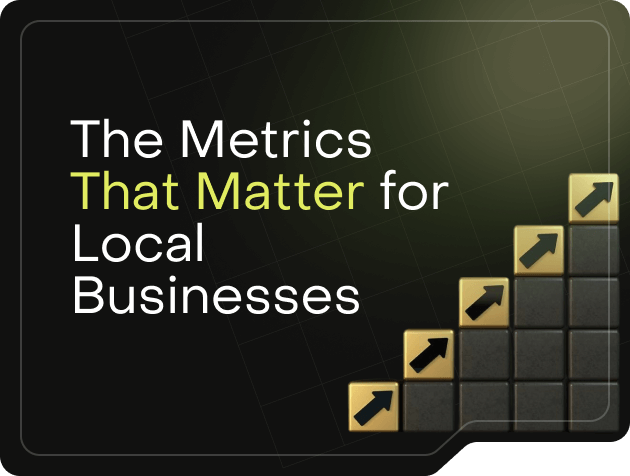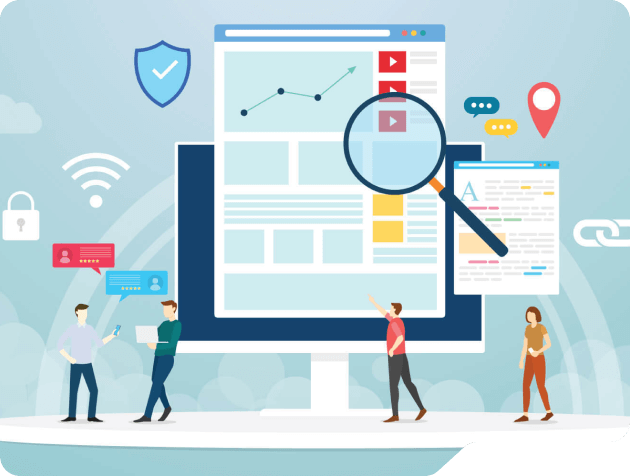According to LivePlan, 90% of businesses that set growth targets fail to track them in real-time, and one in ten have no growth targets at all.
Unsurprisingly, 77% of these businesses generate less than $100K in annual revenue.
This issue turns into more than just a data problem. It’s a growth problem. Many local business owners rely on instinct and hustle instead of insight. However, gut instinct isn’t a scalable strategy.
You need clarity. You need structure. And most of all, you need the right numbers guiding your next move.
In this guide, we’re laying out the top 10 business performance indicators that matter most for local brands.
TL;DR: The Top 10 Metrics Local Businesses Need to Track
|
What Are Local Business Metrics?
Business metrics are measurable values that reveal how effectively your company is operating, growing, and delivering on its goals.
Think of them as your business’s vital signs. Data points that reveal what’s driving momentum, where the leaks are, and where untapped opportunities exist.
The right metrics help answer questions like:
- Are your marketing efforts bringing in high-quality leads?
- Are you pricing your services profitably?
- Are customers satisfied enough to return or recommend your business to others?
- Are your team and systems operating efficiently?
When tracked consistently, these measurable outcomes become your operational playbook. They help you identify patterns, course-correct faster, and make confident decisions that drive predictable growth.
Common Misconception: Metrics aren’t just for agencies or tech startups. They’re essential for every kind of local business, from boutique fitness studios and medspas to HVAC contractors and high-ticket service brands.
Metric #1: Customer Acquisition Cost (CAC)
What it is: CAC reveals how much you spend to land a new customer. It includes ad spend, sales commissions, software costs, and labor tied to prospecting and onboarding.
Why it matters: If you’re spending $500 to acquire a client who only brings in $400 of profit, you’re operating at a loss — even if your top-line revenue looks healthy. Knowing your CAC allows you to scale intelligently and profitably.
How to calculate it:
Total marketing + sales costs ÷ Number of new customers acquired
= CAC
How to improve it:
- Tighten up your lead funnel and cut unqualified traffic
- Invest in conversion-focused landing pages
- Track which campaigns produce the highest LTV customers
Metric #2: Customer Lifetime Value (CLV)
What it is: CLV estimates the total revenue a single customer will bring over the duration of your relationship. For membership-based models, this is especially vital.
Why it matters: CLV tells you what each customer is really worth. It also sets a ceiling for your customer acquisition cost. If a new client will bring in $3,000 over time, spending $500 to acquire them makes perfect sense.
How to calculate it:
Average order value x Purchase frequency x Customer lifespan
= CLV
How to increase it:
- Introduce loyalty and upsell programs
- Create subscription tiers or retainer models
- Improve retention through better onboarding and customer experience
Metric #3: Churn Rate
What it is: Churn rate tracks how many customers stop doing business with you over a given period. For service and subscription businesses, it’s a silent killer.
Why it matters: High churn kills growth. Even if you’re signing up new clients, you’ll never gain traction if you’re losing out on the back end.
How to calculate it:
Customers lost during a period ÷ Total customers at the start of the period
= Churn Rate
How to reduce churn:
- Build in automated follow-ups
- Improve client onboarding and education
- Gather feedback and resolve dissatisfaction proactively
Metric #4: Conversion Rate
What it is: Your conversion rate quantifies the percentage of people who complete a desired action, such as booking a call, signing up for a free trial, or making a purchase.
Why it matters: High traffic means nothing if nobody takes action. Your conversion rate is the ultimate test of how persuasive your messaging, offers, and user experience are.
How to calculate it:
Conversions ÷ Total visitors or leads x 100
= Conversion Rate (%)
How to improve it:
- Test new offers, page layouts, or call-to-action (CTA) copy
- Use testimonials and case studies to increase credibility
- Optimize mobile responsiveness and load speed
Metric #5: Gross Profit Margin
What it is: Gross profit margin shows how much revenue remains after you take away the direct costs of delivering your product or service (cost of goods sold or COGS).
Why it matters: This metric distinguishes between businesses that are growing revenue and profit and those that are merely shifting funds. Strong margins signal pricing power and operational efficiency.
How to calculate it:
(Revenue – COGS) ÷ Revenue x 100
= Gross Profit Margin (%)
How to boost it:
- Raise your prices or package more value into premium offerings
- Negotiate better vendor rates or improve sourcing
- Cut inefficient labor or overdelivery in service execution
Metric #6: Net Promoter Score (NPS)
What it is: NPS measures customer loyalty based on how likely your clients are to recommend your business to others. It’s a single-question survey with powerful predictive value.
Why it matters: A strong NPS reflects exceptional client satisfaction, often the key driver of organic growth. High scores can signal readiness for referrals, testimonials, or even influencer partnerships.
How to calculate it:
Ask customers this: “On a scale of 0-10, how likely are you to recommend us to a friend?”
% Promoters (scores 9–10) – % Detractors (scores 0–6)
= NPS
How to improve it:
- Deliver standout customer experiences consistently
- Resolve issues quickly and proactively
- Follow up with passives (7–8) to convert them into loyalists
Metric #7: Website Traffic Sources
What it is: This performance indicator breaks down how visitors find your website, such as organic search, direct traffic, paid ads, referrals, social, or email campaigns.
Why it matters: Knowing where your traffic originates helps identify which marketing channels are generating awareness and which ones need refinement.
How to analyze it: Utilize platforms like Google Analytics or Semrush to analyze source breakdowns, trends, and engagement patterns.
How to optimize traffic sources:
- Double down on high-converting channels
- Reevaluate spend or messaging for low-performing campaigns
- Ensure your local SEO is working for organic visibility
Metric #8: Average Order Value (AOV)
What it is: AOV reveals the average dollar amount a customer spends per transaction.
Why it matters: Improving this number means increasing revenue without needing more customers, making it a powerful lever for profitability.
How to calculate it:
Total revenue ÷ Number of orders
= AOV
How to increase AOV:
- Offer bundles, upgrades, or limited-time packages
- Use tiered pricing strategies
- Train your team to cross-sell during the sales process
Metric #9: Return on Investment (ROI)
What it is: ROI measures the financial return on a specific investment, like ad spend, a new hire, or a software purchase.
Why it matters: High ROI means your money is working for you, while a low ROI indicates it’s time to reallocate or rethink your strategy.
How to calculate it:
(Revenue gained – Cost of investment) ÷ Cost of investment x 100
= ROI (%)
How to improve it:
- Set clear campaign goals and attribution systems
- Regularly review ad and tool performance
- Trim waste and focus on proven acquisition strategies
Metric #10: Employee Turnover Rate
What it is: This KPI tracks how often team members leave your business, voluntarily or involuntarily, over a specific period.
Why it matters: High turnover drains productivity, damages culture, and costs more than you might think. Low retention often signals deeper operational or leadership gaps.
How to calculate it:
Employees who left ÷ Average number of employees x 100
= Turnover Rate (%)
How to reduce turnover:
- Use tools like Gusto to track team engagement and payroll trends
- Offer career progression pathways and ongoing training
- Foster a strong internal culture rooted in clarity, recognition, and trust
The Best Tools to Track Local Business Metrics
You don’t need a custom dashboard or enterprise suite to track what matters. Here are five powerful, easy-to-integrate tools that local business owners can use to stay on top of their most important data:
1. GoHighLevel: Best All-In-One CRM & Automation Suite
A robust CRM and automation platform tailored for service-based businesses. GoHighLevel helps you track leads, automate follow-ups, manage sales pipelines, and monitor conversion rates — all in one place.
2. Gusto: Best for Payroll, HR, and Employee Retention Metrics
An intuitive payroll, HR, and benefits tool built for small businesses. Gusto allows you to monitor headcount trends, manage employee engagement, and analyze turnover rates.
3. Semrush: Best SEO & Website Traffic Tracking Tool
Semrush is an industry-leading SEO and marketing insights platform. Evaluate your website traffic, keyword rankings, local search performance, and competitor benchmarks with precision.
4. Google Analytics 4 (GA4): Best for Traffic Insights and Funnel Performance
GA4 is Google’s free analytics platform that provides insight on where your website visitors come from, what actions they take, and which channels drive the most engagement.
5. QuickBooks: Best for Financial Visibility
QuickBooks can help you track gross profit margins, monitor expenses, and gain clarity on your financial health. However, you may want to consider hiring a CPA to gain a deeper understanding of your books as you enter a growth phase.
Final Thoughts on Analyzing Local Business Metrics That Help You Scale
If you want to scale with intention, these local business metrics are non-negotiable. They tell the story of your business, highlight bottlenecks, and provide the clarity to make bold, confident moves.
Tracking metrics isn’t about adding more complexity. It’s about creating more simplicity through insight. It’s how you go from operating reactively to growing strategically.
Want help building a growth dashboard tailored to your business?
AVINTIV works with elite local brands to create scalable systems that measure, manage, and multiply growth.
Contact us today to start leveraging your data effectively.

